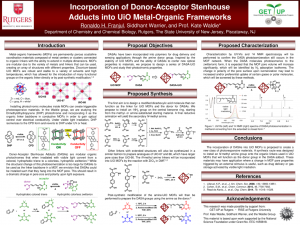Franjul, Ronaldo: Incorporation of Donor-Acceptor Stenhouse Adducts into UiO Metal-Organic Frameworks
Title: Incorporation of Donor-Acceptor Stenhouse Adducts into UiO Metal-Organic Frameworks
Name: Ronaldo Franjul
Home Institute: University of Puerto Rico, Rio Piedras Campus
Programs: RISE program, REU – Green Energy Technology Undergraduate Program (GET UP)
Other contributors: Kate Waldie and Siddhant Warrier
Abstract: Metal-Organic Frameworks (MOFs) are porous crystalline coordination materials composed of metal centers connected by organic linkers that extend in multiple dimensions. The modular nature of MOFs has allowed a wide range of structures to be synthesized that have found use in many applications. The ability to control the bulk properties of a MOF using an external stimulus such as light is of great interest for applications such as optoelectronics, photolithography, and triggered uptake/release of cargo. In the Waldie Group, current research is targeting the installation of an aromatic photochrome into the backbone of MOFs in order to control electrical conductivity using light at particular wavelengths. Herein, this proposal aims to design a new series of light-responsive MOFs where the size and properties of the pores are changed in response to light. For this purpose, a class of organic photochromes called Donor-Acceptor Stenhouse Adducts (DASAs) have been selected, which undergo photoisomerization from a colored, hydrophobic, conjugated structure to a colorless, hydrophilic, zwitterionic form. DASAs have become increasingly popular because the photoswitching is triggered using visible light, unlike most photochromes that require higher energy UV light.
This proposal outlines possible synthetic routes to prepare MOFs that incorporate DASAs onto the organic linker such that the DASA hangs into the pore. Zirconium-based UiO MOFs are selected since these structures are very robust and stable to the introduction of multiple functional groups. The proposed design involves modifying the organic linker of UiO MOFs with a secondary amine, which will function as the donor group for construction of DASAs by post-synthetic modification. Different acceptor groups will be explored to determine their effects on the MOF photochromic properties. Characterization of these new materials will provide key insights into potential applications such as on-demand drug delivery or light-controlled gas storage/release.
Biography: Ronaldo Franjul was born on July 9, 1998 in Passaic, New Jersey and raised in Puerto Rico. He is currently in his junior year at the University of Puerto Rico, Rio Piedras campus. In June, Ronaldo had the opportunity to become a member of the Research Initiative for Student Enhancement (RISE), a program created for the professional and investigative growth of minority students, in order to promote the PhD programs in biomedical fields. For the summer of 2020, Ronaldo participated in the Green Energy Technology Undergraduate Program (GET-UP) at Rutgers University. He worked under the mentorship of Dr. Kate Waldie and his peer mentor Siddhant Warrier. In this experience, Ronaldo had the opportunity to make a proposal in which he sought to incorporate DASAs into UiO metal-organic frameworks. Dr. Waldie and Siddhant gave Ronaldo the opportunity to expose himself to new experiences that made him grow as a person and scientist. Upon completion of his undergraduate chemistry studies, Ronaldo intends to pursue graduate studies in materials science and engineering, with the aim of becoming a materials engineer. What inspires him to become an engineer is the possibility of improving people’s quality of life by creating devices that will be available for all without limitations.
